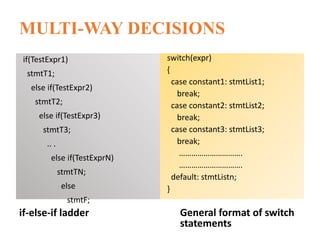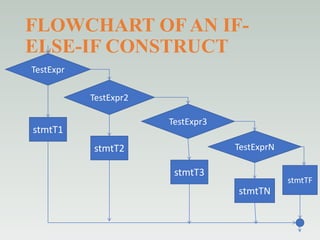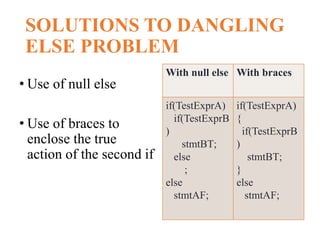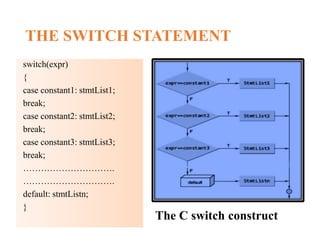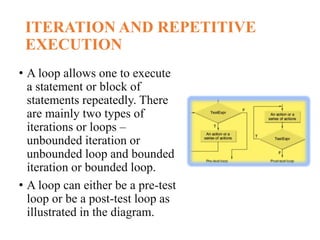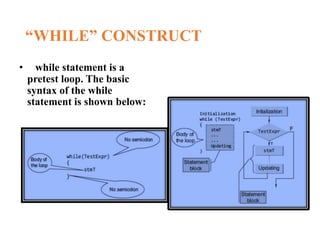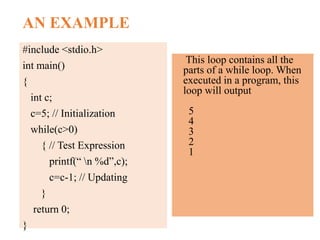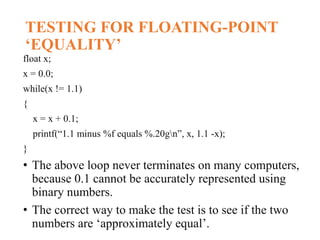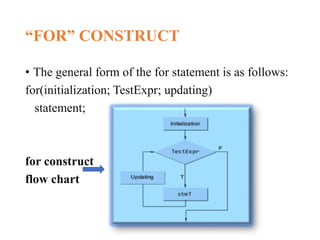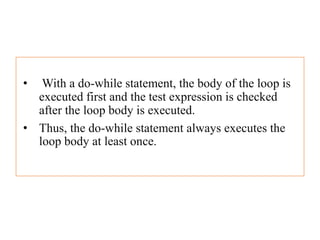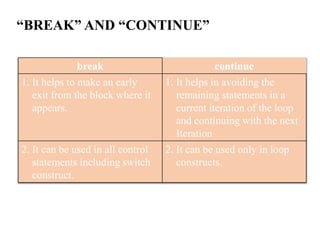C-Programming Control statements.pptx
- 2. LEARNING OBJECTIVES Understanding meaning of a statement and statement block. Learn about decision type control constructs in C and the way these are used. Learn about looping type control constructs in C and the technique of putting them to use. Learn the use of special control constructs such as goto, break, continue, and return. Learn about nested loops and their utility.
- 3. CONTROL STATEMENTS INCLUDE Selection Statements • if • if-else • switch Iteration Statements • for • while • do-while Jump Statements • goto • break • continue • return
- 4. PROGRAM CONTROL STATEMENTS/CONSTRUCTS Program Control Statements/Constructs Selection/Branching Conditional Type if if-else if-else- if switch Unconditional Type break continue goto Iteration/Looping for while do- while
- 5. CONDITIONAL EXECUTION AND SELECTION • Selection Statements • The Conditional Operator • The switch Statement
- 6. SELECTION STATEMENTS • One-way decisions using if statement • Two-way decisions using if-else statement • Multi-way decisions • Dangling else Problem
- 7. ONE-WAY DECISIONS USING IF STATEMENT Flowchart for if construct TestExpr stmtT
- 8. WRITE A PROGRAM THAT PRINTS THE LARGEST AMONG THREE NUMBERS. Algorithm C Program 1. START #include <stdio.h> int main() { int a, b, c, max; printf(“nEnter 3 numbers”); scanf(“%d %d %d”, &a, &b, &c); max=a; if(b>max) max=b; if(c>max) max=c; printf(“Largest No is %d”, max); return 0; } 2. PRINT “ENTER THREE NUMBERS” 3. INPUT A, B, C 4. MAX=A 5. IF B>MAX THEN MAX=B 6. IF C>MAX THEN MAX=C 7. PRINT “LARGEST NUMBER IS”, MAX 8. STOP
- 9. TWO-WAY DECISIONS USING IF-ELSE STATEMENT Flowchart of if-else construct The form of a two-way decision is as follows: if(TestExpr) stmtT; else stmtF; TestExpr stmtT stmtF
- 10. WRITE A PROGRAM THAT PRINTS THE LARGEST AMONG THREE NUMBERS. Algorithm C Program 1. START #include <stdio.h> int main() { int a, b, c, max; printf(“nEnter 3 numbers”); scanf(“%d %d %d”, &a, &b, &c); max=a; if(b>max) max=b; if(c>max) max=c; printf(“Largest No is %d”, max); return 0; } 2. PRINT “ENTER THREE NUMBERS” 3. INPUT A, B, C 4. MAX=A 5. IF B>MAX THEN MAX=B 6. IF C>MAX THEN MAX=C 7. PRINT “LARGEST NUMBER IS”, MAX 8. STOP
- 11. MULTI-WAY DECISIONS if-else-if ladder if(TestExpr1) stmtT1; else if(TestExpr2) stmtT2; else if(TestExpr3) stmtT3; .. . else if(TestExprN) stmtTN; else stmtF; General format of switch statements switch(expr) { case constant1: stmtList1; break; case constant2: stmtList2; break; case constant3: stmtList3; break; …………………………. …………………………. default: stmtListn; }
- 12. FLOWCHART OF AN IF- ELSE-IF CONSTRUCT TestExpr TestExpr2 TestExprN TestExpr3 stmtT2 stmtTN stmtT3 stmtTF stmtT1
- 13. THE FOLLOWING PROGRAM CHECKS WHETHER A NUMBER GIVEN BY THE USER IS ZERO, POSITIVE, OR NEGATIVE int main() { int x; printf(“n ENTER THE NUMBER:”); scanf(“%d”, &x); if(x > 0) printf(“x is positive n”); else if(x == 0) printf(“x is zero n”); else printf(“x is negative n”); return 0;
- 14. NESTED IF • When any if statement is written under another if statement, this cluster is called a nested if. • The syntax for the nested is given here: Construct 1 Construct 2 if(TestExprA) if(TestExprB) stmtBT; else stmtBF; else stmtAF; if(TestExprA) if(TestExprB) stmtBT; else stmtBF; else if(TestExprC) stmtCT; else stmtCF;
- 15. A PROGRAM TO FIND THE LARGEST AMONG THREE NUMBERS USING THE NESTED LOOP int main() { int a, b, c; printf(“nEnter the three numbers”); scanf(“%d %d %d”, &a, &b, &c); if(a > b) if(a > c) printf(“%d”, a); else printf(“%d”, c); else if(b > c) printf(“%d”, b); else printf(“%d”, c); return 0; }
- 16. DANGLING ELSE PROBLEM • This classic problem occurs when there is no matching else for each if. To avoid this problem, the simple C rule is that always pair an else to the most recent unpaired if in the current block. • The else is automatically paired with the closest if. But, it may be needed to associate an else with the outer if also.
- 17. SOLUTIONS TO DANGLING ELSE PROBLEM • Use of null else • Use of braces to enclose the true action of the second if With null else With braces if(TestExprA) if(TestExprB ) stmtBT; else ; else stmtAF; if(TestExprA) { if(TestExprB ) stmtBT; } else stmtAF;
- 18. THE SWITCH STATEMENT The C switch construct switch(expr) { case constant1: stmtList1; break; case constant2: stmtList2; break; case constant3: stmtList3; break; …………………………. …………………………. default: stmtListn; }
- 19. SWITCH VS NESTED IF The switch differs from the else-if in that switch can test only for equality, whereas the if conditional expression can be of a test expression involving any type of relational operators and/or logical operators. A switch statement is usually more efficient than nested ifs. The switch statement can always be replaced with a series of else-if statements.
- 20. ITERATION AND REPETITIVE EXECUTION • A loop allows one to execute a statement or block of statements repeatedly. There are mainly two types of iterations or loops – unbounded iteration or unbounded loop and bounded iteration or bounded loop. • A loop can either be a pre-test loop or be a post-test loop as illustrated in the diagram.
- 21. “WHILE” CONSTRUCT Expanded Syntax of “while” and its Flowchart Representation • while statement is a pretest loop. The basic syntax of the while statement is shown below:
- 22. AN EXAMPLE #include <stdio.h> int main() { int c; c=5; // Initialization while(c>0) { // Test Expression printf(“ n %d”,c); c=c-1; // Updating } return 0; } This loop contains all the parts of a while loop. When executed in a program, this loop will output 5 4 3 2 1
- 23. TESTING FOR FLOATING-POINT ‘EQUALITY’ float x; x = 0.0; while(x != 1.1) { x = x + 0.1; printf(“1.1 minus %f equals %.20gn”, x, 1.1 -x); } • The above loop never terminates on many computers, because 0.1 cannot be accurately represented using binary numbers. • The correct way to make the test is to see if the two numbers are ‘approximately equal’.
- 24. “FOR” CONSTRUCT • The general form of the for statement is as follows: for(initialization; TestExpr; updating) statement; for construct flow chart
- 25. EXAMPLE int main() { int n, s=0, r; printf(“n Enter the Number”); scanf(“%d”, &n); for(;n>0;n/=10) { r=n%10; s=s+r; } printf(“n Sum of digits %d”, s); return 0; }
- 26. “DO-WHILE” CONSTRUCT • The form of this loop construct is as follows: do { statement; /* body of statements would be placed here*/ } while(TestExpression);
- 27. • With a do-while statement, the body of the loop is executed first and the test expression is checked after the loop body is executed. • Thus, the do-while statement always executes the loop body at least once.
- 28. #include <stdio.h> int main() { int x = 1; int count = 0; do { scanf(“%d”, &x); if(x >= 0) count += 1; } while(x >= 0); return 0; }
- 29. Some methods of controlling repetition in a program are: Using Sentinel Values Using Prime Read Using Counter
- 30. GOTO STATEMENT • The control is unconditionally transferred to the statement associated with the label specified in the goto statement. • The form of a goto statement is goto label_name;
- 31. The following program is used to find the factorial of a number. int main() { int n, c; long int f=1; printf(“n Enter the number:”); scanf(“%d”,&n); if(n<0) goto end; for(c=1; c<=n; c++) f*=c; printf(“n FACTORIAL IS %ld”, f); end: }
- 32. “BREAK” AND “CONTINUE” break continue 1. It helps to make an early exit from the block where it appears. 1. It helps in avoiding the remaining statements in a current iteration of the loop and continuing with the next Iteration 2. It can be used in all control statements including switch construct. 2. It can be used only in loop constructs.
- 33. NESTED LOOPS A nested loop refers to a loop that is contained within another loop. If the following output has to be obtained on the screen 1 2 2 3 3 3 4 4 4 4 then the corresponding program will be #include <stdio.h> int main() { int row, col; for(row=1;row<=4;++row) { for(col=1;col<=row;++col) printf(“%d t”, row); printf(“n”); } return 0; }










